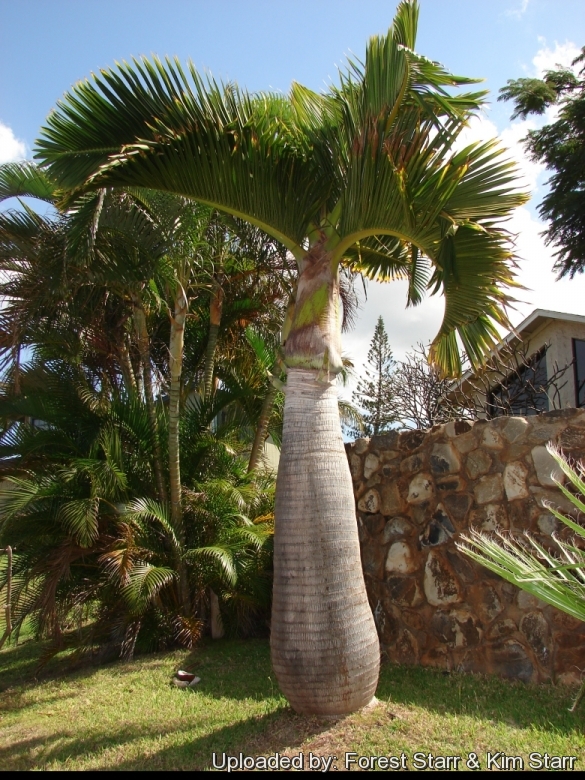
Hyophorbe lagenicaulis Photo by: Forest Starr & Kim Starr
Habit at Pukalani, Maui, Hawaii (USA). March 02, 2007.
Origin and Habitat: Round Island, Mauritius (the Mascarenes) in the Indian Ocean.
Habitat: This species grows in the lowland savannah on fertile volcanic soils among exposed rock. It is endangered in habitat and almost went extinct with fewer than 10 mature trees remaining in the wild because of the lack of regeneration due to the impact of introduced goats and rabbit. However it is very well established in cultivation for its unique beauty throughout the tropics and subtropics as a specimen plant.
Synonyms:
See all synonyms of Hyophorbe lagenicaulis
back
Accepted name in llifle Database:Hyophorbe lagenicaulis (L.H.Bailey) H.E.MoorePrincipes 20(3): 119. 1976Synonymy: 3
back
Common Names include:
ENGLISH: Champagne palm, Bottle coco, Short Bottle palm, Pig nut palm, Bottle palm
CHINESE (中文): Jiu ping ye zi
FRENCH (Français): Palmiste Gargoulette, Palmier bouteille, Palmier bonbonne (Mauritius)
GERMAN (Deutsch): Flaschenpalme, Faßpalme
HINDI ( हिन्दी): बोतल पाम
HUNGARIAN (Magyar): Palackpálma
INDONESIAN (Bahasa Indonesia): Palem botol
JAPANESE (日本語): Tokkuri yashi
KOREAN (한국어): Ju pyeong ya cha
MALAY (بهاس ملاي /Bahasa Melayu ): Palma botol
SPANISH (Español): Palma botella
Description: Hyophorbe lagenicaulisSN|24506]]SN|24506]] is a little dwarf to medium sized palm with distinctive bottle shaped trunk (hence the common name). It will grow slowly to a height of 3-5 (or more) metres. The amazing swollen trunk is the eye catcher on this palm, but it also has other interesting characteristics that come and go as the palm matures from a seedling to a mature specimen. It is a slow grower that can take years to reach its mature height.
Trunk: Massive stumpy fat-bellied, smooth, grey, with noticeable ring scars, widest at the base, tapering upwards to the neck of the bottle formed by the crownshaft, and up to 60 cm in diameter. The trunk is rounded upright and regular, in young specimens and will grow to be elongated and grotesquely distorted as the palm matures. Very young bottle palms often have the trunk covered by persistent leaf bases. It is commonly thought that the swollen trunk is for the purpose of water storage but Hyophorbe lagenicaulisSN|24506]]SN|24506]] is not a succulent plan, it is a myth that the trunk is a means by which the palm stores water.
Crown: Small, sparse, with only 4 to 6(-8) fronds open at any time.
Crownshaft: Smooth that connects the leaves to the trunk. Palm's juvenile period, the crownshaft and leaf petioles are red to orange colour changing to the normal greyish green colour as it matures.
Leaves: Finely pinnate, upwardly arching, 2,5-3,5 m long in mature specimens. Leaflets, stiff, smooth, about 60 cm long and arranged in two upward pointing rows. Petiole small, 15-20 cm long.
Inflorescences: Rise from under the crown at the point where the crownshaft meets the trunk. They grow upward as they mature supporting numeroustiny, cream-coloured flowers on the same stalk. Flowers are monoecious, male and female flowers on the same inflorescence.
Fruit: 2,5 cm round green turning orange to black as they mature.
Bibliography: Major references and further lectures
1) Page, W. 1998. Hyophorbe lagenicaulis. The IUCN Red List of Threatened Species. Version 2014.2. <www.iucnredlist.org>. Downloaded on 30 August 2014.
2) Forest & Kim Starr Hyophorbe lagenicaulis (bottle palm). Plants of Hawaii. <http://www.starrenvironmental.com>. Downloaded on 21 August 2014.
3) John Dransfield, Natalie W. Uhl “Genera Palmarum: the evolution and classification of palms” Kew Pub., 2008
4) Wikipedia contributors. "Hyophorbe lagenicaulis" Wikipedia, The Free Encyclopedia. Wikipedia, The Free Encyclopedia, Accessed on 28 Aug. 2014
5) Don Ellison, Anthony Ellison “Cultivated Palms Of The World” UNSW Press, 01/May/2001
6) Robert Lee Riffle, Paul Craft “An Encyclopedia of Cultivated Palms” Timber Press, Portland 2007
7) New York Botanical Garden “Extinction is forever: threatened and endangered species of plants in the Americas and their significance in ecosystems today and in the future : proceedings of a symposium held at the New York Botanical Garden, May 11-13, 1976, in commemoration of the Bicentennial of the United States of America” New York Botanical Garden, 1977
8) "Hyophorbe lagenicaulis ." PACSOA Palms and Cycads wiki , <http://www.pacsoa.org.au> Accessed on 28 Aug. 2014
9) Palmpedia contributors. "Hyophorbe lagenicaulis ." Palmpedia, PALM ENCYCLOPEDIA, <http://www.palmpedia.net> Downloaded on 26 Aug. 2014
10) Jones, D. L. “Palms throughout the world.” 1994
11) Umberto Quattrocchi "CRC World Dictionary of Plant Nmaes: Common Names, Scientific Names, Eponyms, Synonyms, and Etymology" CRC Press, 17/Nov/1999
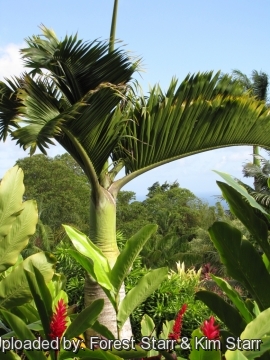 Habit at Garden of Eden Keanae, Maui, Hawaii (USA). March 30, 2011. Photo by: Forest Starr & Kim Starr
Habit at Garden of Eden Keanae, Maui, Hawaii (USA). March 30, 2011. Photo by: Forest Starr & Kim Starr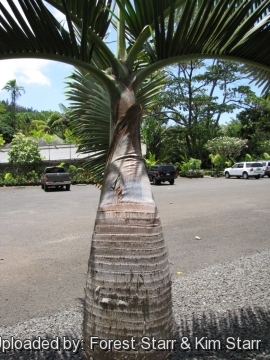 Trunk at Iao Tropical Gardens of Maui, Maui, Hawaii (USA). May 22, 2012. Photo by: Forest Starr & Kim Starr
Trunk at Iao Tropical Gardens of Maui, Maui, Hawaii (USA). May 22, 2012. Photo by: Forest Starr & Kim Starr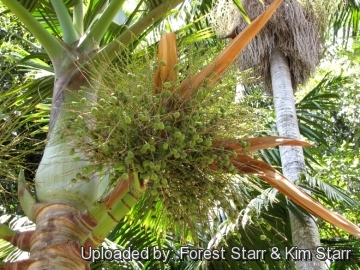 Fruit at Iao Tropical Gardens of Maui, Maui, Hawaii (USA). May 22, 2012. Photo by: Forest Starr & Kim Starr
Fruit at Iao Tropical Gardens of Maui, Maui, Hawaii (USA). May 22, 2012. Photo by: Forest Starr & Kim Starr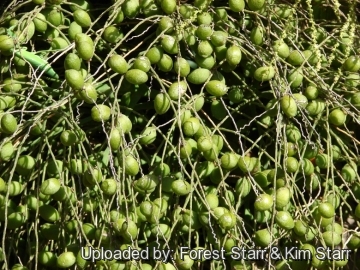 Fruit at Holy Rosary Church Baldwin Ave, Maui, Hawaii (USA). January 11, Photo by: Forest Starr & Kim Starr
Fruit at Holy Rosary Church Baldwin Ave, Maui, Hawaii (USA). January 11, Photo by: Forest Starr & Kim Starr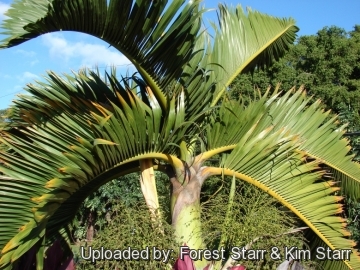 Crown at Holy Rosary Church Baldwin Ave, Maui, Hawaii (USA). January 11, 2007. Photo by: Forest Starr & Kim Starr
Crown at Holy Rosary Church Baldwin Ave, Maui, Hawaii (USA). January 11, 2007. Photo by: Forest Starr & Kim Starr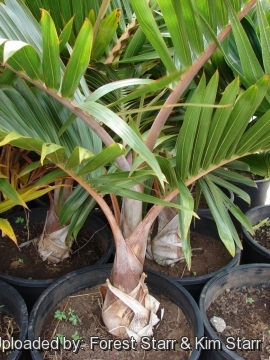 Habit at Home Depot Nursery Kahului, Maui, Hawaii (USA). January 17, 2008. Photo by: Forest Starr & Kim Starr
Habit at Home Depot Nursery Kahului, Maui, Hawaii (USA). January 17, 2008. Photo by: Forest Starr & Kim Starr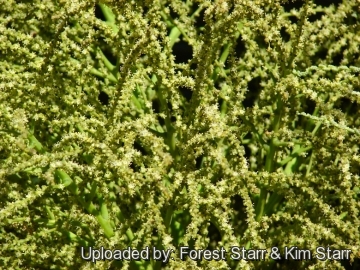 Flowers at Holy Rosary Church Baldwin Ave, Maui, Hawaii (USA). January 11, 2007. Photo by: Forest Starr & Kim Starr
Flowers at Holy Rosary Church Baldwin Ave, Maui, Hawaii (USA). January 11, 2007. Photo by: Forest Starr & Kim Starr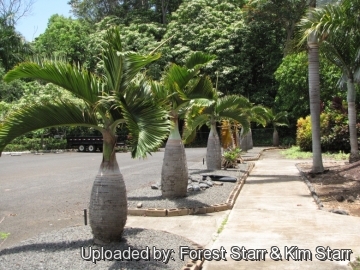 In a row at Iao Tropical Gardens of Maui, Maui, Hawaii (USA). May 22, 2012. Photo by: Forest Starr & Kim Starr
In a row at Iao Tropical Gardens of Maui, Maui, Hawaii (USA). May 22, 2012. Photo by: Forest Starr & Kim StarrCultivation and Propagation: This is an excellent easy to grow palm adapt to tropical and subtropical climates. It unique unique shape and sculptural form together with its small canopy, slow growth and small stature make it suitable for a smaller landscape, or as a large interior potted plant.
Growth Rate: Slow.
Soil requirements: It has a fibrous root system and benefits from deep organic, soils that are fertile, but thrives on wide range of tropical soils, like coastal marine alluvial clays, soils of volcanic origin, sands as long as they are well drained.
Watering: It prefers adequate moisture to look its best. This palm a will tolerate occasional dryness if not prolonged. Don't let sit in water. Indoor, potted palms should not be over-watered. They may contract the fungus Phytophthora, if over-watered.
Light: Prefers broken shade. It can take full sun as it matures if provided adequate water during dry periods. If home-grown, give some sun as with most tropical palms.
Fertilization: Need a perfect fertilizer diet including all micro nutrients and trace elements three times a year if not grown in rich soil.
Aerosol salt tolerance: It is very salt tolerant, but does a lot better inland then it does on the coast.
Hardiness: This palm is tender and is suited for tropical or subtropical climates, it is killed at 0°C or colder for any appreciable length of time, but may survive very light frosts (if very short) even if it end up getting nearly defoliated each winter. (USDA Zones 10-11) Any temps below 4° C degrees call for protection for this palm. Seedling growth arrestes below 15°C.
Its cousin, spindle palm (Hyophorbe vershaffeltii), is hardier and can handle some frost and temperatures to about -3° C for short periods.
Wind hardiness: It is very tolerant and even survives to strong hurricane wind with minimal damages, but will grow better with slow wind.
Propagation: The fresh seeds take 4-6 months to germinate. If not properly treated, the seed does not have long shelf life.
Garden uses: It is an excellent landscaping palm when set out on the lawn as a specimen, especially for small gardens where other palms will grow out of scale. Plant bottle palms in containers and feature it in a prominent spot on the patio. Mass plantings are common at median strips and roundabouts in tropical towns.

















